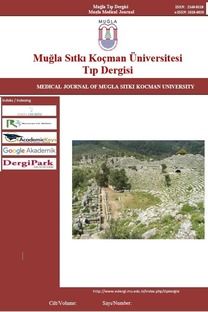Türk Toplumundaki Primer Diz Osteoartriti (OA) ile MMP-1 ve
MMP3 Gen Polimorfizmleri Arasındaki İlişki: Topluma Dayalı Bir Olgu
Kontrol Çalışması
AbstractThe development of matrix metalloproteinases (MMPs) plays a key role in the normal physiology of connective tissue during morphogenesis and wound healing. The irregular synthesis and activity of MMPs can be related with osteoarthritis (OA) which is a major cause of disability in elderly population. We have determined the relationship between occurrence of knee OA and MMP-1 single nucleotide polymorphism (SNP) rs5854 (A/G) and MMP-3 SNP rs679620 (C/T) in 100 primary knee OA patients and 83 healthy controls in Turkey, using the ABI 7500 real-time PCR system. Genotypic distributions and allelic frequencies were compared between the patient and control groups considering age, gender and body mass index (BMI). We found no significant difference between the two groups in genotype distribution and allelic frequency of MMP-1 rs5854 and MMP-3 rs679620. The A‑ and G‑allele frequencies were 31% and 69% in OA patients, respectively, and 27% and 73% in the control group. Stratification analysis revealed that there was no difference in the association between presence of OA in rs679620 (MMP-3) CT heterozygotes and CC homozygotes in either gender. The GG, GA and AA genotypes of rs5854 (MMP-1) were not significantly associated with the risk of knee OA, even after further stratification analysis according to gender. We conclude that MMP-1 G/A gene AND MMP-3 C/T polymorphisms do not have a role in the development of knee OA in a Turkish population. Keywords: Gene, Metalloproteinases, Osteoarthritis, PolymorphismÖzetMatriks metalloproteinazların gelişimi, yara iyileşmesi ve morfogenez sırasında konnektif dokunun normal fizyolojisinde anahtar bir rol oynar. Metalloproteinaz (MMP)’lerin aktivitesi ve düzensiz sentezi yaşlı nüfusunda sakatlıkların ana bir nedeni olan osteoartrit ile ilişkili olabilir. Türkiye’de 100 primer diz osteoartrit (OA) hastası ve 83 sağlıklı kontrol grubunda diz OA oluşumu ile MMP-1 tek nükleotid polimorfizm (TNP) rs5854 (A/G) ve MMP-3 TNP rs679620 (C/T) arasındaki ilişkiyi ABI 7500 real-time PCR sistemi kullanılarak tanımladık. Genotipik dağılım ve allelik sıklıkları hasta ve kontrol gruplarının yaş, cinsiyet ve vücut kitle indeksleri (VKİ) düşünülerek karşılaştırıldı. İki grup arasında MMP-1 rs5854 ve MMP-3 rs679620 genotipik dağılım ve allelik sıklıklarında anlamlı fark saptanmadı. A ve G allel sıklıkları OA hastalarında sırasıyla %31 ve %69, kontrol grubunda %27 ve %73 olarak bulunmuştur. Stratifikasyon analizinde cinsiyette de rs679620 (MMP-3) CT heterozigot and CC homozigotları ile OA in varlığı arasında ilişki saptanmamıştır. rs5854 (MMP-1) ün GG, GA ve AA genotipleri ile diz OA in riski arasında cinsiyete göre stratifiye edildikten sonra bile önemli ilişki bulunamamıştır. MMP-1 G/A gen ve MMP-3 C/T polimorfizmleri ile Türk halkındaki diz OA in gelişimi arasında bir role sahip olmadığı sonucuna vardık.
The Relationship Between Primary Knee Osteoarthritis (OA) and MMP-1 and MMP-3 Gene Polymorphisms in a Turkish Population: A Population-Based Case-Control Study
The development of matrix metalloproteinases (MMPs) plays a key role in the normal physiology of connective tissue during morphogenesis and wound healing. The irregular synthesis and activity of MMPs can be related with osteoarthritis (OA) which is a major cause of disability in elderly population. We have determined the relationship between occurrence of knee OA and MMP-1 single nucleotide polymorphism (SNP) rs5854 (A/G) and MMP-3 SNP rs679620 (C/T) in 100 primary knee OA patients and 83 healthy controls in Turkey, using the ABI 7500 real-time PCR system. Genotypic distributions and allelic frequencies were compared between the patient and control groups considering age, gender and body mass index (BMI). We found no significant difference between the two groups in genotype distribution and allelic frequency of MMP-1 rs5854 and MMP-3 rs679620. The A- and G-allele frequencies were 31% and 69% in OA patients, respectively, and 27% and 73% in the control group. Stratification analysis revealed that there was no difference in the association between presence of OA in rs679620 (MMP-3) CT heterozygotes and CC homozygotes in either gender. The GG, GA and AA genotypes of rs5854 (MMP-1) were not significantly associated with the risk of knee OA, even after further stratification analysis according to gender. We conclude that MMP-1 G/A gene AND MMP-3 C/T polymorphisms do not have a role in the development of knee OA in a Turkish population
